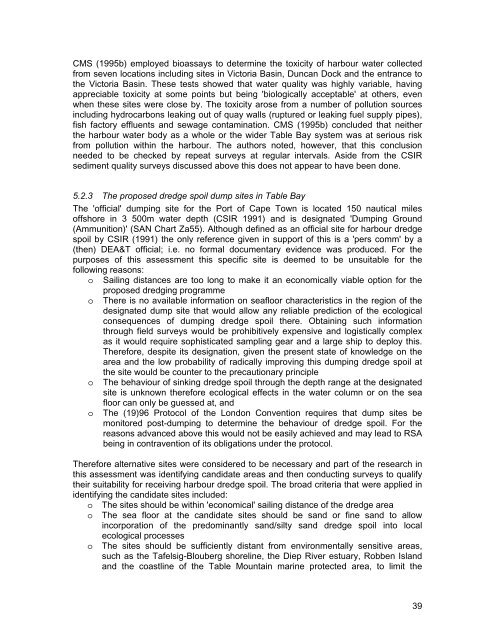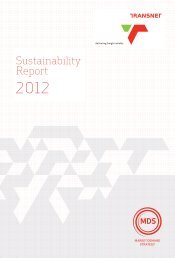BEN SCHOEMAN DOCK BERTH DEEPENING Specialist ... - Transnet
BEN SCHOEMAN DOCK BERTH DEEPENING Specialist ... - Transnet
BEN SCHOEMAN DOCK BERTH DEEPENING Specialist ... - Transnet
You also want an ePaper? Increase the reach of your titles
YUMPU automatically turns print PDFs into web optimized ePapers that Google loves.
CMS (1995b) employed bioassays to determine the toxicity of harbour water collected<br />
from seven locations including sites in Victoria Basin, Duncan Dock and the entrance to<br />
the Victoria Basin. These tests showed that water quality was highly variable, having<br />
appreciable toxicity at some points but being 'biologically acceptable' at others, even<br />
when these sites were close by. The toxicity arose from a number of pollution sources<br />
including hydrocarbons leaking out of quay walls (ruptured or leaking fuel supply pipes),<br />
fish factory effluents and sewage contamination. CMS (1995b) concluded that neither<br />
the harbour water body as a whole or the wider Table Bay system was at serious risk<br />
from pollution within the harbour. The authors noted, however, that this conclusion<br />
needed to be checked by repeat surveys at regular intervals. Aside from the CSIR<br />
sediment quality surveys discussed above this does not appear to have been done.<br />
5.2.3 The proposed dredge spoil dump sites in Table Bay<br />
The 'official' dumping site for the Port of Cape Town is located 150 nautical miles<br />
offshore in 3 500m water depth (CSIR 1991) and is designated 'Dumping Ground<br />
(Ammunition)' (SAN Chart Za55). Although defined as an official site for harbour dredge<br />
spoil by CSIR (1991) the only reference given in support of this is a 'pers comm' by a<br />
(then) DEA&T official; i.e. no formal documentary evidence was produced. For the<br />
purposes of this assessment this specific site is deemed to be unsuitable for the<br />
following reasons:<br />
o Sailing distances are too long to make it an economically viable option for the<br />
proposed dredging programme<br />
o There is no available information on seafloor characteristics in the region of the<br />
designated dump site that would allow any reliable prediction of the ecological<br />
consequences of dumping dredge spoil there. Obtaining such information<br />
through field surveys would be prohibitively expensive and logistically complex<br />
as it would require sophisticated sampling gear and a large ship to deploy this.<br />
Therefore, despite its designation, given the present state of knowledge on the<br />
area and the low probability of radically improving this dumping dredge spoil at<br />
the site would be counter to the precautionary principle<br />
o The behaviour of sinking dredge spoil through the depth range at the designated<br />
site is unknown therefore ecological effects in the water column or on the sea<br />
floor can only be guessed at, and<br />
o The (19)96 Protocol of the London Convention requires that dump sites be<br />
monitored post-dumping to determine the behaviour of dredge spoil. For the<br />
reasons advanced above this would not be easily achieved and may lead to RSA<br />
being in contravention of its obligations under the protocol.<br />
Therefore alternative sites were considered to be necessary and part of the research in<br />
this assessment was identifying candidate areas and then conducting surveys to qualify<br />
their suitability for receiving harbour dredge spoil. The broad criteria that were applied in<br />
identifying the candidate sites included:<br />
o<br />
o<br />
o<br />
The sites should be within 'economical' sailing distance of the dredge area<br />
The sea floor at the candidate sites should be sand or fine sand to allow<br />
incorporation of the predominantly sand/silty sand dredge spoil into local<br />
ecological processes<br />
The sites should be sufficiently distant from environmentally sensitive areas,<br />
such as the Tafelsig-Blouberg shoreline, the Diep River estuary, Robben Island<br />
and the coastline of the Table Mountain marine protected area, to limit the<br />
39

















